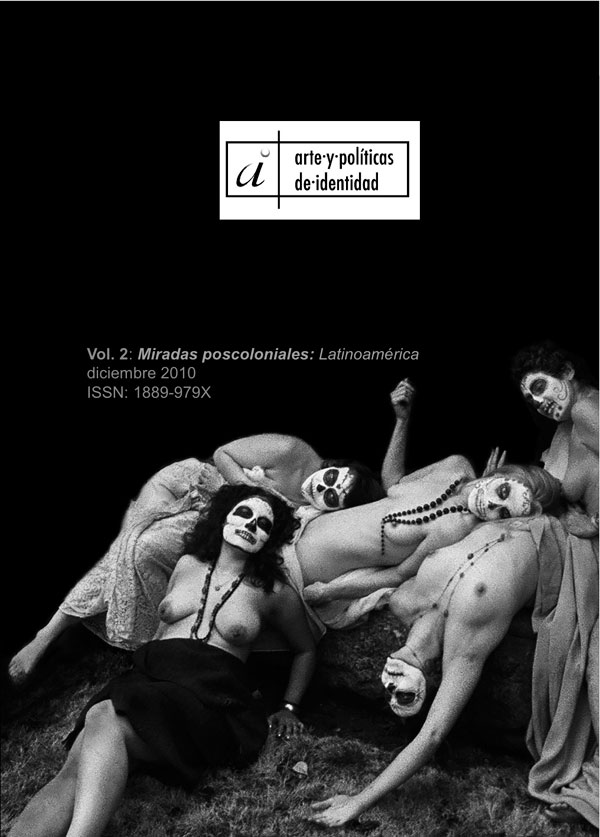Desynchronized: Migratory times and Images of displacement
Abstract
This essay explores the ways in which migration, conceived not only as a movement in space but essentially as a movement in time, can contribute to demolish the illusory, monolithic conception of temporality in the Global World. Going beyond the theories of hybridization, that tend to find a sort of agreement between different times (a third time), I find synchronization impossible and I claim a model of time capable to deal with conflicts, blind spots and ‘dyschronys’: a sort of ‘fourth time’, an antagonistic temporality that shows us that migration is always ‘out of the clock’. That fourth, conflictive time is enacted and embodied in some recent works of art. Departing from the idea that visual art can made us understand contemporary problems even better than our humanistic practices of writing, I try to examine some video artworks that show us migration as an ‘out of synch’ experience.Downloads
-
Abstract426
-
PDF (Español (España))488
References
Agacinski, Sylviane (2000). Le passeur de temps. Modernité et nostalgie. París: Seuil.
Aubarell, Gemma y Roca Parés, Albert (Eds.). (2003). Perspectivas de la inmigración en España. Barcelona: Icaria Editorial.
Augé, Marc (1996). Los no lugares. Espacios del anonimato. Barcelona: Gedisa.
Baier, Lothar (2002). Pas le temps! Traité sur l’accélération. Translated by Marie-Hélène Desort and Peter Krauss. París: Actes Sud.
Bal, Mieke (1999). Quoting Caravaggio: Contemporary Art, Preposterous History. Chicago: University of Chicago Press.
---------(2008). Double Movement. In Mieke Bal & Miguel Hernández-Navarro, 2Move: Video Art Migration (pp.13-80). Murcia: Cendeac.
Benjamin, Walter (1996) [1939]. La dialéctica en suspenso. Fragmentos sobre la historia. Edición de Pablo Oyarzún. Santiago de Chile: LOM Ediciones.
Bhabha, Homi (2002). El lugar de la cultura. Buenos Aires: Manantial.
Bottomley, Gillian (2010). From Another Place: Migration and the Politics of Culture. Cambridge: Cambridge University Press.
Bruno, Giuliana, (2007). Public Intimacy. Architecture and Visual Arts. Cambridge, Mass: The MIT Press.
Capurro, R., Frühbauer, J. y Hausmanninger, Th., (Eds.). (2007). Localizing the Internet. Ethical Aspects in Intercultural Perspective. Munich: Wilhelm Fink Verlag.
Doane, Mary Ann (2002). The Emergence of Cinematic Time. Moderninty, Contingence, the Archive. Cambridge & London: Harvard University Press.
Durrant, Sam y Lord, Catherine M. (Eds.). (2007). Essays in Migratory Aesthetics: Cultural Practices Between Migration and Art-making. Amsterdam: Rodopi.
Eco, Umberto (1977). Tratado de semiótica general. Madrid: Lumen.
Freud, Sigmund (1984) [1920]. Más allá del principio del placer. Madrid: Alianza.
García Canclini, Néstor (1999). La globalización imaginada. Buenos Aires: Paidós.
-------- (2009). Extranjeros en la tecnología y en la cultura. Barcelona: Ariel.
Hannerz, Ulf (1998). Conexiones transnacionales. Madrid: Cátedra.
Jenkins, Henry (2006). Convergence Culture. Where Old and New Media Collide. New York & London: New York University Press.
Koselleck, Reinhard (2001). Los estratos del tiempo. Estudios sobre la historia. Barcelona: Paidós.
Laclau, Ernesto y Mouffe, Chantal (1985). Hegemonía y estrategia socialista. Hacia una radicalización de la democracia. México: Fondo de Cultura Económica.
Lipovetsky, Gilles y Charles, Sebastien (2006). Los tiempos hipermodernos. Barcelona: Anagrama.
Marzo, Jorge Luis (2003). Me, Mycell and I. Tecnología, movilidad y vida social.Barcelona: Fundación Tapies.
Massey, Doreen (2005). For Space. London: Sage Publications.
May, Jon & Thrift, Nigel (Eds.). (2001). Timespace. Geographies of Temporality.London: Routledge. Mercer, Kobena (Ed.). (2008). Exiles, Diasporas & Strangers. Cambridge, Mass: MIT Press.
Negri, Antonio (1982). Macchina tempo. Rompicapi, liberazione, constituzione. Milano: Feltrinelli.
Ragland, Ellie & Milovanovic, Dragan (Eds.). (2004). Lacan: Topologically Speaking.New York: Other Press.
Rancière, Jacques (2007). El desacuerdo: política y filosofía. Buenos Aires: Nueva Visión.
Ramírez, Jacques P. (2007). Aunque se fue tan lejos nos vemos todos los días: migración transnacional y uso de nuevas tecnologías de comunicación. En Consuelo Albornoz et al. (Eds.), Los usos de Internet: Comunicación y sociedad. Tomo 2. Quito: Flacso Ecuador.
Rodríguez, Nora (2008). Educar desde el locutorio. Barcelona: Plataforma Editorial.
Smith, Terry (2009). What Is Contemporary Art? Chicago: The University of Chicago Press.
Urry, John (2003). Global Complexity. Cambridge: Polity Press.
Valencia, Guadalupe (2007). Entre cronos y kairós. Las formas del tiempo sociohistórico. Barcelona: Anthropos.
Virilio, Paul (2006). Velocidad y política. Buenos Aires: La Marca.
Works published in this journal are subject to the following terms:
- The Service of Publications from the University of Murcia (publishing house) keeps the published works’ copyrights, and favors and allows the reuse of these works under the license indicated in point 2.
- Works are published in the journal’s online edition under the license Creative Commons Reconocimiento-NoComercial-SinObraDerivada 3.0 España(texto legal). They can be copied, used, disseminated, transmitted and publicly exhibited, as long as: i) the author and original source of publication are cited (journal, publishing house and work’s URL); ii) they are not used for commercial purposes; iii) the existence and specifications of this license are mentioned.
3. Conditions for auto-file. It is allowed and encouraged that authors share electronically their pre-print version (the pre-reviewed version) and /or post-print version (the reviewed and accepted version) of their Works before the publication, since it promotes its circulation and dissemination. RoMEO color: green.










